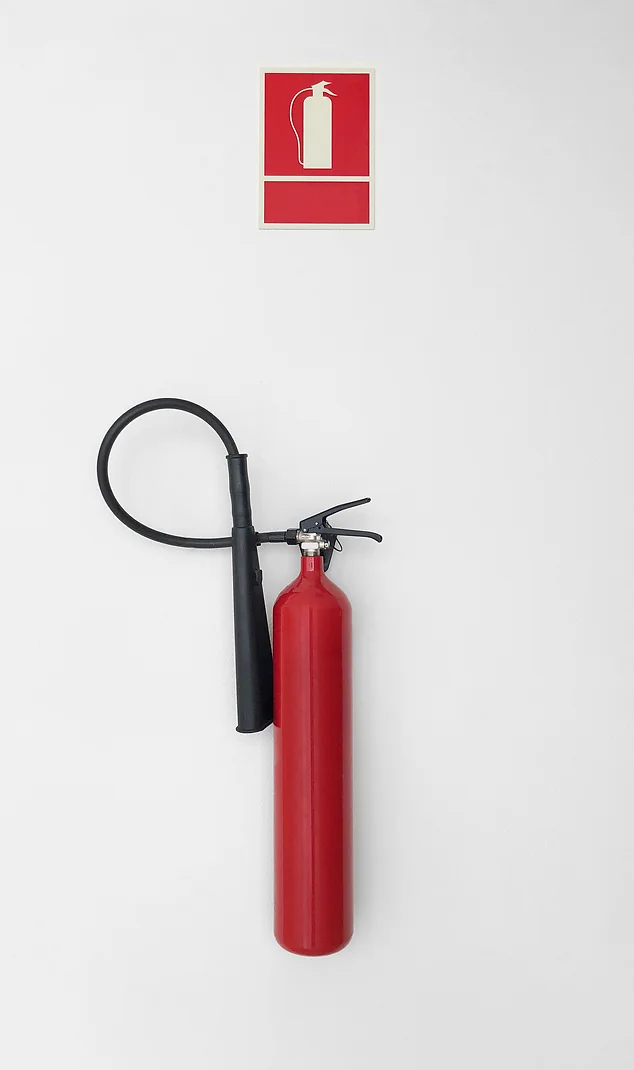
Fire Extinguisher Services
We evaluate all fire extinguishers for corrosion, damage, and proper functionality. Below are the following services offered.

- Monthly or annual Fire Extinguisher Inspections per NFPA 10 requirements
- Inspect / tag fire extinguishers at commercial, industrial, and government installations
- Provide required 6-year / 12-year testing on dry powder extinguishers
- Provide 5-year testing on Class K fire extinguishers (Fire Extinguishers used in Commercial Kitchens)
- Provide 5-year high-pressure hydro test and recharge on CO2 fire extinguishers
- Provide Fire Extinguisher Training and hands-on demonstrations
- Provide consultation about what type, size, and quantity you need for your business
Dry Powder Fire Extinguishers
How Do Dry Powder Extinguishers Work?
Dry Powder Extinguishers extinguish the fire by separating the fuel from the oxygen element or by removing the heating element of the fire triangle. However, dry powder extinguishers are for Class D or combustible metal fires, only. They are ineffective on all other classes of fires.
Safe on live electrical equipment, although does not penetrate the spaces in equipment easily and the fire may re-ignite. This type of extinguisher does not cool the fire very well and care should be taken so that the fire does not flare up again. Smoldering material in deep-seated fires such as upholstery or bedding can cause the fire to start up again. Do not use on domestic chip or fat pan fires. There is a danger of inhalation if powder extinguishers are used within buildings.
Similarly to almost all extinguishing agents, the powders act as a thermal ballast making the flames too cool for the chemical reactions to continue. Some powders also provide a minor chemical inhibition, although this effect is relatively weak. These powders thus provide rapid knockdown of flame fronts, but may not keep the fire suppressed.
How Do I use Dry Powder Extinguishers?
Point the jet or discharge horn at the base of the flames and, with a rapid sweeping motion, drive the fire towards the far edge until all the flames are out. If the extinguisher has hand control, wait until the air clears, and if you can still see the flames, attack the fire again.
Wet Chemical Fire Extinguishers
How Do Wet Chemical Extinguishers Work?
A Wet Chemical Extinguisher extinguishes the fire by removing the heat of the fire triangle and prevents re-ignition by creating a barrier between the oxygen and fuel elements.
The wet chemical of Class K extinguishers was developed for modern, high-efficiency deep-fat fryers in commercial cooking operations. Some may also be used on Class A fires in commercial kitchens.
Most class K extinguishers contain a solution of potassium acetate, sometimes with some potassium citrate or potassium bicarbonate. The extinguishers spray the agent out as a fine mist. The mist acts to cool the flame front, while the potassium salts saponify the surface of the burning cooking oil, producing a layer of foam over the surface. This solution thus provides a similar blanketing effect to a foam extinguisher, but with a greater cooling effect. The saponification only works on animal fats and vegetable oils, so most class K extinguishers cannot be used for class B fires. The misting also helps to prevent splashing the blazing oil.
Tests have established that a 6-liter wet chemical fire extinguisher with a 75F rating can deal with a fat fire of a maximum 0.11 m2 surface area.
What Are Chemical Fire Extinguishers Best Used For?
Wet chemical fire extinguishers are ideal for Class K fires, involving cooking oils and fats, such as lard, olive oil, sunflower oil, maize oil, and butter.
How Do I Use Chemical Fire Extinguishers?
Apply the wet chemical using the extended applicator in slow circular movements, which gives a gentle, yet highly effective application. Apply the fine spray onto the burning fat until the surface of the burning cooking oil changes into a soapy-like substance which prevents re-ignition. The gentle application helps to prevent burning oil from splashing out of the container. Make sure that you empty the entire content of the wet chemical extinguisher onto the oil/fat, as the fire can re-ignite otherwise.
CO2 Fire Extinguishers
What Is A C02 Extinguisher?
Carbon Dioxide extinguishers are filled with non-flammable carbon dioxide gas under extreme pressure. You can recognize a CO2 extinguisher by its hard horn and lack of pressure gauge. The pressure in the cylinder is so great that when you use one of these extinguishers, bits of dry ice may shoot out the horn. CO2 Extinguishers are designed for Class B and C (flammable liquid and electrical) fires only.
What Do C0
CO2 cylinders are red and range in size from 5 lbs to 100 lbs or larger. In the larger sizes, the hard horn will be located on the end of a long, flexible hose.
How Do C0
Carbon dioxide extinguishes work by displacing oxygen or taking away the oxygen element of the fire triangle. The carbon dioxide is also very cold as it comes out of the extinguisher, so it cools the fuel as well. CO2s may be ineffective at extinguishing Class A fires because they may not be able to displace enough oxygen to successfully put the fire out. Class A materials may also smolder and re-ignite.


